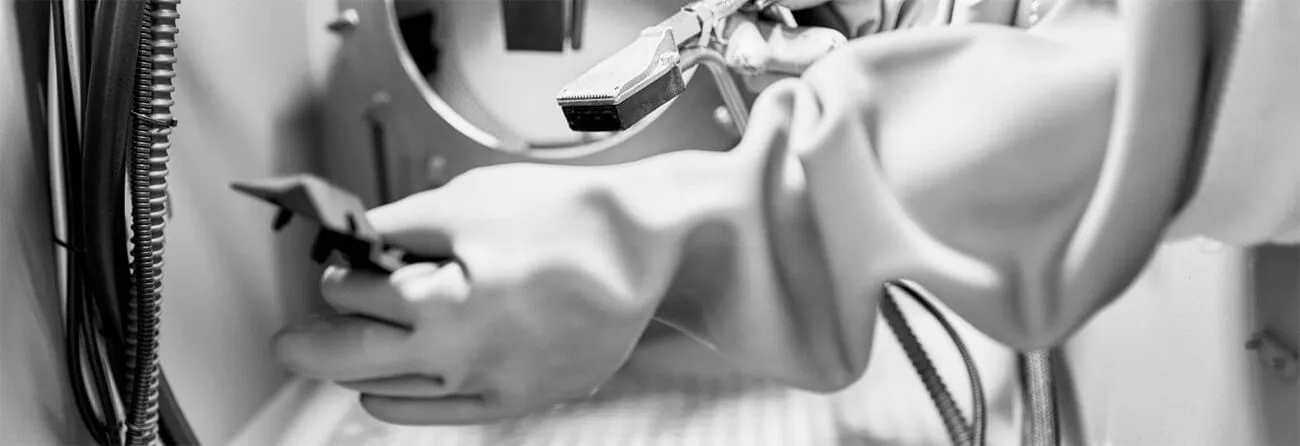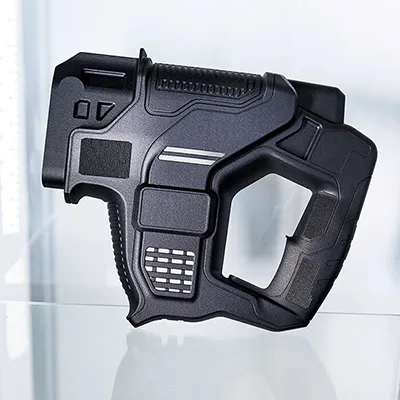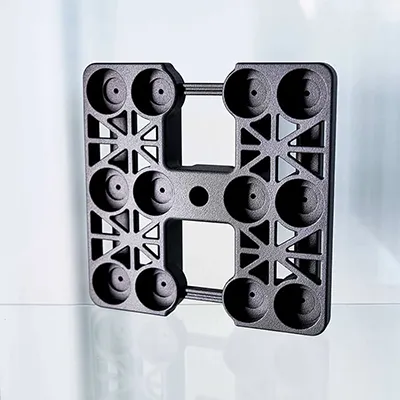Shot Peening (or “compaction” or “compression blasting”) is part of the post-processing process in 3D printing. The surface treatment leads to modified mechanical properties, especially compaction and increased scratch resistance of the surfaces, as well as improving the aesthetics and haptics of the components.
Shot Peening at 3Faktur
3Faktur uses a modified blasting cabinet of the type SMG 50, converted for this purpose by “MHG Strahlkabinen”. The special equipment of the cabinet is necessary because the process leads to a high static charge of the blasting material, which is reduced by the processing cabinet.
Shot peening is generally applied to all black-colored components at 3Faktur. It is not necessary to order this service separately.

Operation
In compaction blasting, the 3D-printed and colored components are blasted with plastic balls. The relatively large balls have high kinetic energy, resulting in a locally high temperature upon impact. As a result, the surface is compacted and the porosity is reduced.
Shot peening is distinct from regular cleaning blasting, where all components produced in the production process are blasted and cleaned of residual powder. In this case, glass beads with a significantly smaller grain size are used, which reliably clean but do not compact the surfaces.
3Faktur uses the Multi Jet Fusion process for the additive manufacturing of plastic components. This powder-based technology produces surfaces that are relatively rough (Ra 7 – 10 µm) and slightly porous, which can be refined with shot peening.
Shot peening is a secondary blasting process that is only applied to black-colored components.
Applications


Shot peening is used for visible components. Therefore, we apply this process as a standard for all black-colored components at 3Faktur.
The decision whether to use shot peening (“compaction blasting”) or vapor smoothing (“chemical smoothing”) depends on the desired effect and the geometry of the component:
- Chemical Smoothing: more gloss, lower roughness, small and/or irregular components
- Shot Peening: usually higher homogeneity, large and/or flat surfaces
Special Features
Shot peening is a cost-effective finishing process. It is particularly suitable for homogeneous, pleasant-to-touch surface structures and provides higher scratch resistance to the components. Its advantages lie in improved homogeneity and haptics.
However, shot peening does not result in a surface without pores (comparable to chemical smoothing). Therefore, this post-processing method is not suitable for use in gas- and liquid-tight components or surfaces that require easy cleaning in cleanrooms or medical technology.
Practical Implementation of Shot Peening
The components to be processed are blasted in a specially equipped blasting cabinet. Round plastic beads are used as the blasting material, which have significantly less wear compared to the ceramic beads used for regular cleaning blasting. The components are placed in a drum or manually processed, depending on their shape and size.
During the blasting process, the components are exposed to the kinetic energy of the plastic beads, which leads to the desired compaction of the surfaces. The impact energy of the beads causes local heating, resulting in the compaction of the surface structure.
The shot peening process is not suitable for all materials. In particular, components made of non-colorable materials such as polypropylene or PEBA cannot be processed with this method.
FAQ Shot Peening
What is shot peening?
Shot peening is a surface treatment process that involves bombarding a material’s surface with small spherical particles (shots) to improve its mechanical properties, such as compaction, strength, and fatigue resistance.
What is the purpose of shot peening in 3D printing?
In 3D printing, shot peening is commonly used as a post-processing technique to enhance the mechanical properties and surface quality of printed components. It helps to compact the surface, reduce porosity, and improve scratch resistance.
Which components are suitable for shot peening?
Shot peening is typically applied to black-colored components produced using the Multi Jet Fusion process at 3Faktur. It is not suitable for non-colorable materials like polypropylene or PEBA.
What is the difference between shot peening and regular cleaning blasting?
Shot peening and regular cleaning blasting are two different surface treatment processes. Shot peening uses relatively large plastic balls to compact the surface and reduce porosity, while regular cleaning blasting uses smaller glass beads to remove residual powder and clean the components.
Can shot peening make a surface pore-free?
No, shot peening does not make a surface pore-free. While it improves the surface structure and reduces porosity, it does not eliminate all pores. If a pore-free surface is required, other post-processing methods like chemical smoothing may be more suitable.
What are the advantages of shot peening?
Shot peening offers several advantages, including improved surface homogeneity, pleasant haptics (touch), and higher scratch resistance. It is a cost-effective finishing process for enhancing the mechanical properties of 3D-printed components.
Is shot peening suitable for gas- and liquid-tight components?
No, shot peening is not suitable for gas- and liquid-tight components or surfaces that require easy cleaning in cleanrooms or medical technology. It does not result in a pore-free surface required for such applications.
What factors should be considered when choosing between shot peening and chemical smoothing?
The choice between shot peening and chemical smoothing depends on the desired effect and the geometry of the component. Chemical smoothing provides more gloss, lower roughness, and is suitable for small and/or irregular components. Compaction blasting (shot peening) offers higher homogeneity and is typically used for large and/or flat surfaces.
